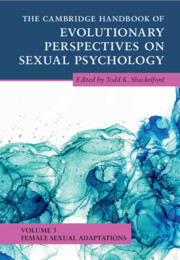Book contents
- The Cambridge Handbook of Evolutionary Perspectives on Sexual Psychology
- The Cambridge Handbook of Evolutionary Perspectives on Sexual Psychology
- Copyright page
- Contents
- Contributors
- Preface
- Part I Precopulatory Adaptations
- 1 Women’s Preferences: Precopulatory Adaptations
- 2 Female Sexual Attraction Tactics
- 3 Extra-Pair Sexual Interest
- 4 Female Intrasexual Competition
- 5 Female Intersexual Selection
- 6 Evolution of Precopulatory Defense from Rape and Coercion in Women
- 7 Mate Poaching
- Part II Copulatory Adaptations
- Part III Postcopulatory Adaptations
- Index
- References
1 - Women’s Preferences: Precopulatory Adaptations
from Part I - Precopulatory Adaptations
Published online by Cambridge University Press: 30 June 2022
- The Cambridge Handbook of Evolutionary Perspectives on Sexual Psychology
- The Cambridge Handbook of Evolutionary Perspectives on Sexual Psychology
- Copyright page
- Contents
- Contributors
- Preface
- Part I Precopulatory Adaptations
- 1 Women’s Preferences: Precopulatory Adaptations
- 2 Female Sexual Attraction Tactics
- 3 Extra-Pair Sexual Interest
- 4 Female Intrasexual Competition
- 5 Female Intersexual Selection
- 6 Evolution of Precopulatory Defense from Rape and Coercion in Women
- 7 Mate Poaching
- Part II Copulatory Adaptations
- Part III Postcopulatory Adaptations
- Index
- References
Summary
This chapter focuses on women’s preferences in mate selection, which have evolved as a suite of adaptations designed to solve women’s problems associated with reproduction. We first summarize basic differences in women’s reproductive rate and metabolic costs associated with reproduction that have shaped women’s mating preferences. We then summarize women’s short-term-mating preferences, designed primarily to identify mates who possess “good genes” cues that would ensure healthy offspring, followed by a summary of women’s long-term mating preferences, designed primarily to identify mates capable and interested in investing in women and offspring. We discuss how women’s ovulatory cycle, in which conception risk varies across their monthly cycle, modulates women’s mating preferences, particularly short-term mating preferences. This is followed by a summary of how environmental factors, such as the presence of resources or threatening conspecifics, modulate women’s mating preferences, indicating the context-sensitivity of women’s preferences. Finally, we discuss how individual differences in women’s personality traits further modulate short-term and long-term mating preferences.
- Type
- Chapter
- Information
- Publisher: Cambridge University PressPrint publication year: 2022



